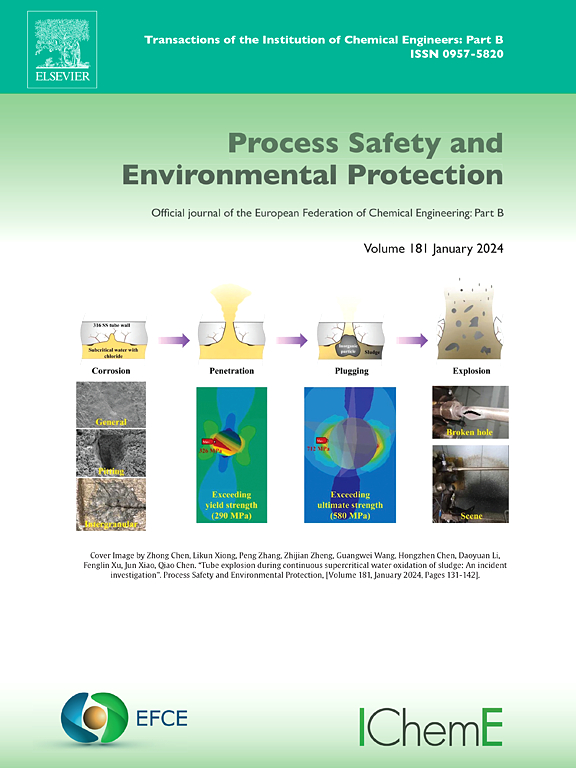Dual skeleton network in situ-construction of alkaline anion-exchange membrane for boosting water electrolysis at low concentration of alkaline solution
IF 6.9
2区 环境科学与生态学
Q1 ENGINEERING, CHEMICAL
引用次数: 0
Abstract
As the core component of anion-exchange membrane water electrolysis (AEMWE), the search for AEM with high conductivity and good stability is particularly pursued. In this work, we report the synthesis of a series of anion-exchange membranes (PCG-GA@V-CS) with polyvinyl alcohol (PVA) and chitosan (CS) as a dual skeleton followed by the introduction of quaternary ammonium guar hydroxypropyltrimethylammonium chloride (CG) as an anion-exchange moiety. By in-situ conduction with glutaraldehyde (GA) as cross-linking agent, the PCG-GA2@V-CS anion-exchange membrane featuring cross-transfer dual network structure was successfully established, which manifests good ionic conductivity (19.8 mS cm−1), ion mobility number (0.89), dimensional stability, and mechanical property (15.99 MPa in fully hydrated). Under low concentration alkaline conditions, the PCG-GA2@V-CS membrane displays a high current density of 550 mA cm−2 @ 2.0 V at 80 °C in AEMWE when coupled by nickel mesh catalytic electrode. Notably, the PCG-GA2@V-CS membrane can conduct AEMWE in 1 M KOH with a stable operation for more than fifty hours, which largely surpasses the FAB-PK-130 under the same conditions. This work provides a novel methodology for PVA-based anion-exchange membrane by coupling double skeleton regulation and in-situ cross-linking technique for boosting AEMWE at low concentration of alkaline solution.
双骨架网原位构建促进低浓度碱性溶液电解的碱性阴离子交换膜
作为阴离子交换膜水电解(AEMWE)的核心部件,寻找具有高导电性和良好稳定性的AEM尤为重要。在这项工作中,我们报道了以聚乙烯醇(PVA)和壳聚糖(CS)为双骨架,引入季铵盐瓜尔胶羟丙基三甲基氯化铵(CG)作为阴离子交换部分合成了一系列阴离子交换膜(PCG-GA@V-CS)。以戊二醛(GA)为交联剂,原位导电制备了具有交叉转移双网络结构的PCG-GA2@V-CS阴离子交换膜,具有良好的离子电导率(19.8 mS cm−1)、离子迁移率(0.89)、尺寸稳定性和力学性能(完全水合时15.99 MPa)。在低浓度碱性条件下,PCG-GA2@V-CS膜与镍网催化电极偶联,在80 °C的AEMWE中显示出550 mA cm−2 @ 2.0 V的高电流密度。值得注意的是,PCG-GA2@V-CS膜可以在1 M KOH中进行AEMWE,稳定运行50小时以上,大大超过了相同条件下的FAB-PK-130。本研究通过双骨架调控耦合和原位交联技术,为pva阴离子交换膜在低浓度碱性溶液中提高AEMWE提供了一种新的方法。
本文章由计算机程序翻译,如有差异,请以英文原文为准。
求助全文
约1分钟内获得全文
求助全文
来源期刊

Process Safety and Environmental Protection
环境科学-工程:化工
CiteScore
11.40
自引率
15.40%
发文量
929
审稿时长
8.0 months
期刊介绍:
The Process Safety and Environmental Protection (PSEP) journal is a leading international publication that focuses on the publication of high-quality, original research papers in the field of engineering, specifically those related to the safety of industrial processes and environmental protection. The journal encourages submissions that present new developments in safety and environmental aspects, particularly those that show how research findings can be applied in process engineering design and practice.
PSEP is particularly interested in research that brings fresh perspectives to established engineering principles, identifies unsolved problems, or suggests directions for future research. The journal also values contributions that push the boundaries of traditional engineering and welcomes multidisciplinary papers.
PSEP's articles are abstracted and indexed by a range of databases and services, which helps to ensure that the journal's research is accessible and recognized in the academic and professional communities. These databases include ANTE, Chemical Abstracts, Chemical Hazards in Industry, Current Contents, Elsevier Engineering Information database, Pascal Francis, Web of Science, Scopus, Engineering Information Database EnCompass LIT (Elsevier), and INSPEC. This wide coverage facilitates the dissemination of the journal's content to a global audience interested in process safety and environmental engineering.
 求助内容:
求助内容: 应助结果提醒方式:
应助结果提醒方式:


